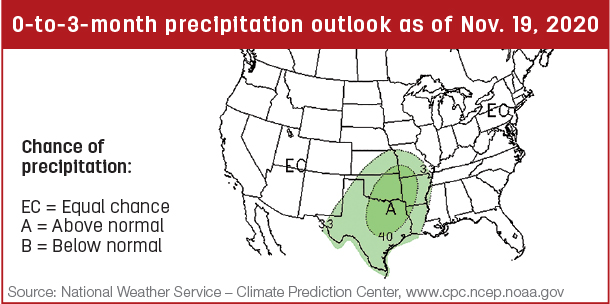Unfortunately, drought and abnormally dry conditions continue to expand in a large portion of the south-central region as of this writing. Additionally, current projections through the end of February call for drought to continue in current areas and for drought to develop in almost all of the south-central region. The current drought map and seasonal drought outlook can be found online (Drought Monitor).

While some have been dealing with drought conditions longer than others, it is important for everyone to consider management plans for the end of the winter and what happens if drought or dry conditions continue into the spring. A few key questions to ask when making additional management plans:
- At the current pace, will the stored or stockpiled forages last the rest of the winter?
- Are there forage resources available if drought continues into the spring?
- Are there forage resources available if drought conditions improve but grazing in the spring is delayed or reduced?
- Does it make more financial sense to continue to feed and try to stretch limited forage resources or implement greater herd reductions?
If the decision is made to stretch or continue to stretch limited forage resources, be mindful of costs and also how various feeding strategies can affect rumen health. Stretching limited forages supplies generally involves feeding a minimum amount of roughage, an energy source like whole shelled corn to replace some of the hay or forage needed, a protein supplement and an appropriate mineral supplement.
When considering feeds, remember that fiber does not always equal roughage. Fiber-based feeds like soybean hulls and corn gluten feed are good energy sources, but they don’t provide meaningful roughage. Additionally, “hay stretcher” or “forage extender” cubes very rarely provide meaningful roughage and are often low in energy and expensive for what little they offer. Instead of using “hay stretcher” or “forage extender” cubes, using a high-energy, low-fiber cube and feeding a traditional roughage source is often much cheaper and also better for rumen health.
Don’t forget to take advantage of example drought diets and other resources on university websites as well as industry professionals when putting a plan together.









